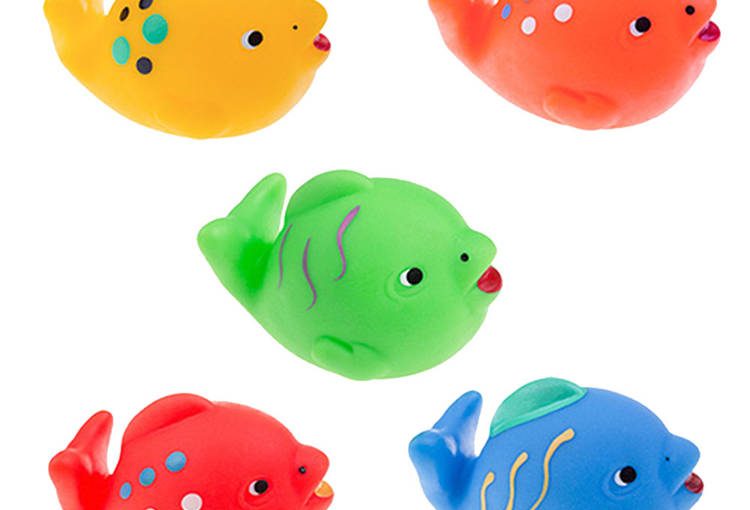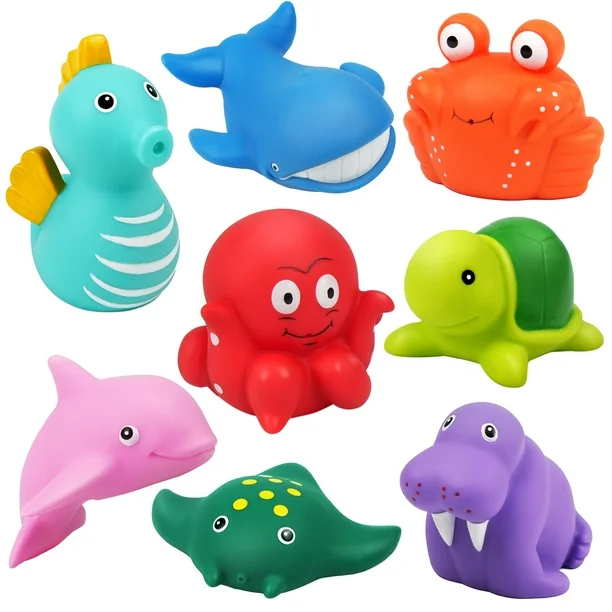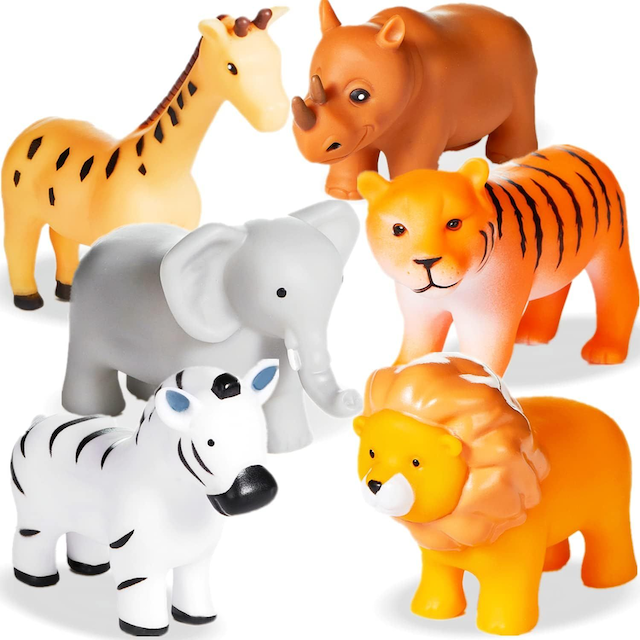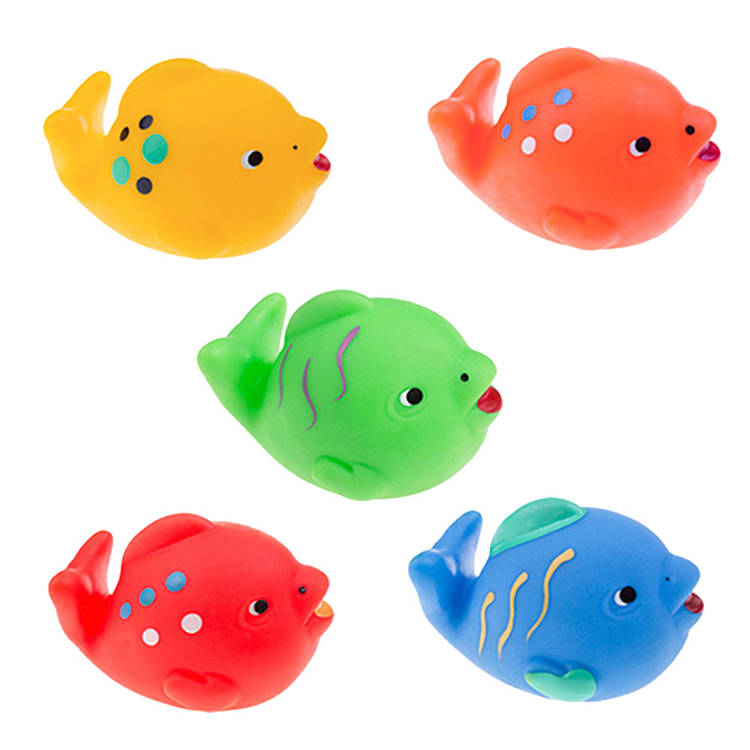Importance of Non-toxic Materials in Bath Toys
The safety of toddlers is paramount when selecting bath toys. Non-toxic materials in rubber bath toys prevent harmful chemicals from harming a child’s health. These materials ensure that when toys inevitably end up in toddlers’ mouths, there is no risk of ingestion of toxic substances.
Moreover, non-toxic rubber bath toys are better for the environment. They reduce the risk of environmental pollution. When discarded, these toys break down more safely and cleanly.
Parents and caregivers should always check for labels that indicate a toy is free from BPA, phthalates, and PVC. These chemicals can disrupt hormonal balance and cause developmental issues in young children.
When evaluating rubber bath toys, prioritize items made from 100% natural rubber. This material is renewable, biodegradable, and less likely to trigger allergies. It’s a safer choice for bath time fun.
Always look for rubber bath toys with certifications that verify their non-toxic status. The ‘CE’ mark or ‘ASTM’ standards are typically reliable indicators of safety.
In summary, ensuring the use of non-toxic materials in rubber bath toys helps safeguard your child’s health. It promotes a less polluted environment and aligns with rigorous safety standards.
Selection Criteria for Safe Rubber Bath Toys
Choosing the right rubber bath toys for your toddler involves careful consideration. To guarantee both fun and safety during bath time, here are some key selection criteria to keep in mind:
- Non-toxic Materials: Always opt for rubber bath toys that are free from BPA, phthalates, and PVC. These harmful chemicals can affect your child’s health negatively.
- Quality Certifications: Look for toys that carry the ‘CE’ mark, comply with ‘ASTM’ standards, or other relevant safety certifications. These marks are your assurance that the toy meets strict safety guidelines.
- Durable and Resilient: Pick toys made of sturdy natural rubber. They should be able to withstand frequent use and the inevitable chewing by toddlers.
- Easy to Clean: Toys with simple designs are easier to clean thoroughly, preventing mold growth and ensuring hygiene.
- Age-Appropriateness: Ensure that the toy is suitable for your toddler’s age. Toys should not have small parts that pose a choking hazard.
- Sensory Stimulation: Consider toys that stimulate the senses. Bright colors, textures, and gentle squeaks can enhance tactile and auditory development.
- Environmental Impact: Biodegradable and eco-friendly toys reflect a responsible choice for the planet.
By following these criteria, you can make informed choices about the rubber bath toys you introduce to your toddler’s bath time routine. Remember, a safe toy is paramount to an enjoyable and secure bath time experience.
Top Rated Rubber Bath Toys for Toddlers
When searching for the best rubber bath toys for your toddler, certain products consistently receive high praise. These top-rated toys meet all the safety and enjoyment criteria. To help parents make a wise choice, the following list outlines some of the favorites.
- 100% Natural Rubber Duck: A classic choice, natural rubber ducks avoid harmful chemicals and are perfect for teething toddlers.
- Eco-Friendly Sea Creatures: Made from non-toxic, biodegradable materials, these toys come in shapes like fish and turtles, making bath time an underwater adventure.
- Soft Squirt Toys: These toys are durable, easy to clean, and free from BPA and phthalates, providing endless fun without the risk.
- Educational Alphabet Set: Combine learning with play by introducing letters that stick to the tub walls, made from safe rubber materials.
Parents should choose rubber bath toys that have positive reviews for safety, durability, and entertainment value. Always read feedback from other buyers to ensure a toy’s quality and resistance to mold and mildew formation. Lastly, remember to verify that the chosen toys hold the safety certifications like ‘CE’ or ‘ASTM’, which reassure you of their non-toxic nature.
Cleaning and Maintenance of Rubber Bath Toys
Cleaning and maintenance are crucial to extend the life and safety of rubber bath toys. Keeping toys clean prevents the buildup of soap scum and harmful bacteria, which can be detrimental to your child’s health. Here are simple yet effective steps to maintain your toddler’s rubber bath toys:
- Regular Rinsing: After each bath, rinse toys under hot running water. This washes away soap and shampoo residues.
- Thorough Drying: Squeeze out any water trapped inside the toys. Allow them to air dry completely to avoid mold growth.
- Weekly Disinfecting: Soak the toys in a mixture of warm water and vinegar. This natural solution is effective in killing germs.
- Proper Storage: Store toys in a dry place with good airflow. Using a toy net or hanging them helps prevent moisture buildup.
- Inspect for Damage: Check regularly for cracks or tears. Damaged toys can harbor bacteria or become a choking hazard.
- Avoid Harsh Chemicals: Use gentle, baby-safe cleaners. Strong chemicals may degrade the rubber and are not safe for toddlers.
By diligently cleaning and maintaining rubber bath toys, parents can ensure a healthier bath time environment. Remember, toys with intricate designs may need extra attention while cleaning. Regular maintenance can also spot early signs of wear, which is key in preventing safety issues.
Common Safety Concerns with Rubber Bath Toys
Ensuring rubber bath toys are safe for toddlers entails being aware of various safety concerns. Here’s a list of frequent issues to be mindful of:
- Choking Hazards: Small parts can break off from rubber bath toys.
- Chemical Exposure: In products not marked as non-toxic, dangerous chemicals like BPA may lurk.
- Mold and Bacteria: Moist environments cause mold and bacteria to grow inside toys.
Parents and caregivers should thoroughly inspect toys before purchase and regularly during use. Look for any sign of wear or damage that could create small parts. Always choose toys labeled as BPA-free and made of natural rubber to minimize chemical exposure. After play, squeeze out water and dry toys completely to prevent mold.
Vigilance and choosing the right products are key. This ensures a safe play experience during bath time for your toddler.
Alternatives to Rubber Bath Toys for Toddlers
When considering bath toys for toddlers, rubber may not always be the best fit for every family. If you’re looking for alternatives to rubber bath toys, there are plenty of options. Here are some safe and enjoyable substitutes:
- Silicone Toys: They are soft, easy to clean, and free from harmful chemicals.
- Fabric Bath Toys: Made from quick-drying materials, they reduce the risk of mold and are often machine washable.
- Plastic Bath Toys with Safety Certifications: Certain plastics are non-toxic and safe, just look for BPA and phthalate-free labels.
- Natural Sponge Toys: These are soft and suitable for sensitive skin, offering a gentle way to play.
- Wooden Toys Coated with Safe Paints: Ensure the paint is non-toxic and the wood is sealed to prevent swelling and splintering.
- DIY Toys: Create your own from household items that are large enough to avoid choking hazards and have no sharp edges.
When choosing these alternatives, still prioritize safety features such as non-toxic materials, no small parts, and ease of cleaning. Diverse bath toys can contribute to your child’s development while ensuring a safe, hygienic play environment in the bathtub.
Tips for Introducing Bath Toys to Toddlers
Introducing bath toys can turn bath time into a fun learning experience for toddlers. Here are some tips to make the introduction as enjoyable and safe as possible:
- Start with a Few: Begin with a small selection of rubber bath toys. Too many can be overwhelming.
- Demonstrate Play: Show your toddler how to play with the toys. Lead by example and encourage imitation.
- Engage Their Senses: Choose toys that appeal to sight, touch, and sound. Bright colors and textures can stimulate development.
- Keep it Interactive: Play games and create stories with the toys to make bath time engaging.
- Ensure Supervision: Always stay close and watch your toddler during bath time. Safety comes first.
- Introduce Variety Gradually: As your child grows accustomed, gradually add different toys to keep interest high.
- Stay Consistent with Safety: Remind your child that bath toys are only for the tub to avoid any safety hazards around the house.
- Encourage Clean-Up: Make cleaning up part of the routine. This teaches responsibility and ensures toys stay hygienic.
- Check for Signs of Wear: Regularly inspect toys for any damage that could pose risks.
By following these tips, you can help your toddler have a blast during bath time while keeping safety a top priority.
Regulatory Standards and Certifications for Child Safety
When selecting rubber bath toys for toddlers, understanding regulatory standards and certifications is crucial. These are set in place to ensure that products meet specific safety requirements before they reach your home. Here are essential points to consider regarding regulatory standards and child safety certifications:
- Check for Marks of Authenticity: Look for the ‘CE’ mark on toys, which signifies European conformity with health, safety, and environmental protection standards.
- US Standards Compliance: In the US, ensure toys meet the ‘ASTM’ (American Society for Testing and Materials) standards, a benchmark for child safety.
- Toxic Substances Control: Certifications often include checks for toxic substances. Toys should pass tests that show they are free from harmful levels of chemicals like BPA and phthalates.
- Physical & Mechanical Tests: Toys undergo rigorous physical and mechanical tests to ensure they can withstand typical stress and don’t create a choking hazard.
- Regular Updates on Standards: Safety standards are regularly updated. Stay informed about the latest regulations affecting toddler toys.
- International Standards: If you’re buying toys from international brands, check if they comply with the ISO (International Organization for Standardization) safety standards.
By adhering to these guidelines and checking for the proper certifications, you can confidently choose rubber bath toys that are not only fun but also safe for your toddler’s use. Always verify the authenticity of certifications to ensure they are up to date and relevant.



